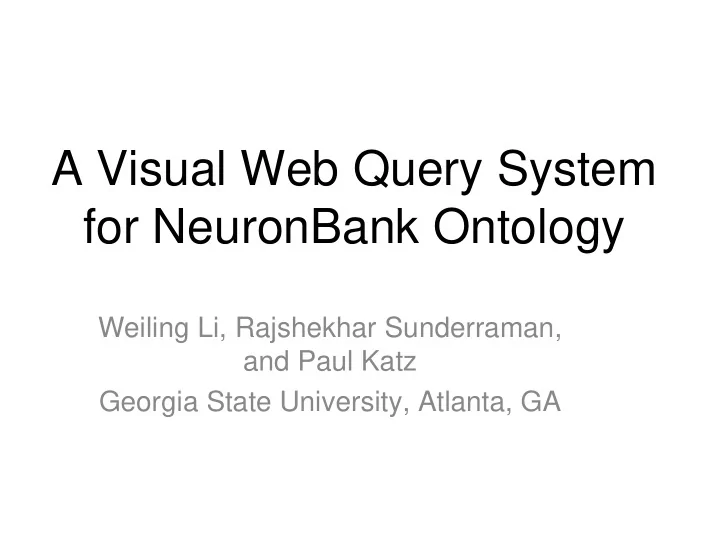

A Visual Web Query System for NeuronBank Ontology Weiling Li, Rajshekhar Sunderraman, and Paul Katz Georgia State University, Atlanta, GA
Outline • Introduction • Query sub-system overview • Comparison with other visual query systems • Conclusion
Understanding the brain requires understanding its circuitry http://www.cajal.csic.es/V
Problem: We are using publications as a method to catalog neurons and neural circuits Information is distributed and fragmented. No means to efficiently search this knowledge. No means to publish incremental knowledge without a functional story.
Our Approach • Traditional databases are not a good fit for the problem of storing information about neural circuitry • Changes in representation would cause the database schema to change • Ontology: A formal representation of a set of concepts within a domain and the relationships between those concepts • We created a ontology for each species built upon the premise that some concepts are common across species.
NeuronBank.org: A Neuromics Tool • NeuronBank is to neurons. – A place to publish knowledge about neurons and neural connectivity – A tool to search, analyze, and share knowledge of neurons and neural circuitry. – An ontology-based knowledge base system
NeuronBank.org: A Neuromics Tool
NeuronBank.org: A Neuromics Tool
NeuronBank.org: A Neuromics Tool
NeuronBank.org: A Neuromics Tool DSI
NeuronBank.org: A Neuromics Tool
NeuronBank.org: A Neuromics Tool DSI
NeuronBank.org: A Neuromics Tool
NeuronBank.org: A Neuromics Tool
NeuronBank.org: A Neuromics Tool
Architeture of NeuronBank
Query component • ontology-based Web query interface. • Algernon system on frame-based knowledge bases. • JavaServer Faces (JSF) technology. • The form-based query is translated into a textual Algernon query.
Query system architecture Server Client Request Query Generation Ontology Schema Retrieve User Interface Retriever Response Return Ontology back-ends Sending form-based Algernon query expression Query Result Display Sending User Interface result back Text Algernon Query Generator Summary Page Return Sending text-based results Link to Algernon query expression Detail Page Query Algernon Engine Return results
Query generation user interface Starting point A list of properties to build a whose data types are form-based class or a set of classes query in the ontology Activate Class list Class list Class list ∙ ∙ ∙ Property list Property list Property list A list of properties with primitive data Construct form-based types Algernon query expression Query Criteria Panel
• Class lists activate (b) Relationship Properties of Selected (a) The start dropdown menu Class in next Column
• Property list boxes Primitive Properties of Selected Class - in Property List-Box • Query Criteria Panel – a form-based interface – construct Algernon query expressions
An Example Form-based Search Find all neurons which are involved in chemical synapses satisfying the following two properties: 1. the connection probability of the synapse is greater than 2, and 2. the synapse has an article annotation which was published after year 2000.
Query results • Cross Branch Query Results • Summary Page
Query results (Contd) • Detail Page
Algernon query generation • create a query for a neuron ( (:INSTANCE -Neuron ?Col0_Returns) )
• Choose a chemical synapse (whose parent is Inputs), which has relationship with the neuron. ( (:INSTANCE -Neuron ?Col0_Returns) (-Inputs ?Col0_Returns ?Col1_Returns) (:INSTANCE – Chemical_Synapse ?Col1_Returns) )
• choose the -Connection Probability property of the Chemical Synapse, whose parent class is - My Properties. • click the “Add” button • set the value of that chosen property is larger than 2 in the query criterion. • The updated Algernon query is: ( (:INSTANCE -Neuron ?Col0_Returns) (-Inputs ?Col0_Returns ?Col1_Returns) (:INSTANCE -Chemical_Synapse ?Col1_Returns) (-My_Properties ?Col1_Returns ?Col1_Cond_Prop6) (:CHILD -Connection_Probability?Col1_Cond_Prop6 ?Col1_Cond6) (-Value ?Col1_Cond6 ?Col1_Cond6_Values) (:test (:lisp (> ?Col1_Cond6_Values 2))) )
• choose the article sub-class from the third pulldown menu of classes which is a relationship property of the chemical synapse. The parent class for the article sub-class is My_Annotations. ( (:INSTANCE -Neuron ?Col0_Returns) (-Inputs ?Col0_Returns ?Col1_Returns) (:INSTANCE -Chemical_Synapse ?Col1_Returns) (-My_Properties ?Col1_Returns ?Col1_Cond_Prop6) (:CHILD -Connection_Probability?Col1_Cond_Prop6 ?Col1_Cond6) (-Value ?Col1_Cond6 ?Col1_Cond6_Values) (:test (:lisp (> ?Col1_Cond6_Values 2))) (-My_Annotations ?Col1_Returns ?Col2_Returns) (:INSTANCE -Article ?Col2_Returns) )
• choose the primitive property -Year of the article class. • Upon clicking the “Add” button, the system introduces a second row in the query criteria panel. • enter the value of the year property as larger than 2000. • The final Algernon query is generated: ( (:INSTANCE -Neuron ?Col0_Returns) (-Inputs ?Col0_Returns ?Col1_Returns) (:INSTANCE -Chemical_Synapse ?Col1_Returns) (-My_Properties ?Col1_Returns ?Col1_Cond_Prop6) (:CHILD -Connection_Probability?Col1_Cond_Prop6 ?Col1_Cond6) (-Value ?Col1_Cond6 ?Col1_Cond6_Values) (:test (:lisp (> ?Col1_Cond6_Values 2))) (-My_Annotations ?Col1_Returns ?Col2_Returns) (:INSTANCE -Article ?Col2_Returns) (-Year ?Col2_Returns ?Col2_Cond_Prop12) (:test (:lisp (> ?Col2_Cond_Prop12 2000))) )
Comparison • Web-based. • Retrieving ontology schema on demand and facilitating to construct a query expression with the minimal database knowledge. • Returning not only the final results, but also all intermediate results.
Conclusion and future work • Web query sub-system of NeuronBank. – Primitive properties of classes can be queried by the users as well as relationships with other classes. – The user can follow a chain of relationships to formulate complex queries. • Future work: – query arbitrary Ontologies that are stored in Protege Frames. – modified to work with RDF/OWL Ontologies as well. SPARQL queries will have to be generated in this case.
Thank You for your time and attention Questions?
Recommend
More recommend